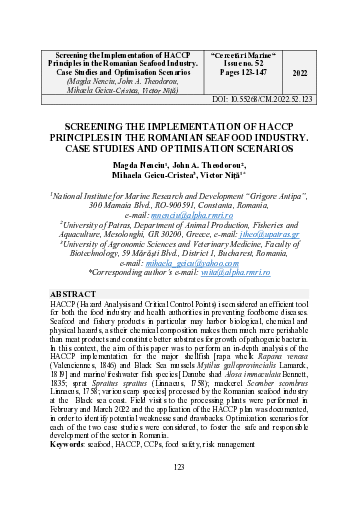Screening the Implementation of HACCP Principles in the Romanian Seafood Industry. Case Studies and Optimisation Scenarios
DOI:
https://doi.org/10.55268/CM.2022.52.123Keywords:
seafood, HACCP, CCPs, food safety, risk managementAbstract
HACCP (Hazard Analysis and Critical Control Points) is considered an efficient tool for both the food industry and health authorities in preventing foodborne diseases. Seafood and fishery products in particular may harbor biological, chemical and physical hazards, as their chemical composition makes them much more perishable than meat products and constitute better substrates for growth of pathogenic bacteria. In this context, the aim of this paper was to perform an in-depth analysis of the HACCP implementation for the major shellfish [rapa whelk Rapana venosa (Valenciennes, 1846) and Black Sea mussels Mytilus galloprovincialis Lamarck, 1819] and marine/freshwater fish species [Danube shad Alosa immaculata Bennett, 1835; sprat Sprattus sprattus (Linnaeus, 1758); mackerel Scomber scombrus Linnaeus, 1758; various carp species] processed by the Romanian seafood industry at the Black sea coast. Field visits to the processing plants were performed in February and March 2022 and the application of the HACCP plan was documented, in order to identify potential weaknesses and drawbacks. Optimization scenarios for each of the two case studies were considered, to foster the safe and responsible development of the sector in Romania.
Downloads
Published
How to Cite
Issue
Section
License
Copyright (c) 2025 Magda Nenciu, John-A. Theodorou, Mihaela Geicu-Cristea, Victor Niță

This work is licensed under a Creative Commons Attribution-NonCommercial-NoDerivatives 4.0 International License.
This is an open access journal, which means that all content is freely available without charge to the user or his/her institution. Users are allowed to read, download, copy, distribute, print, search, or link to the full texts of the articles, or use them for any other lawful purpose, without asking prior permission from the publisher or the author. This is in accordance with the BOAI definition of open access.






